This cultured vegan almond cheese recipe makes a nice, mild, spreadable vegan cheese with a bit of tang and a subtle, musky flavour reminiscent of goat cheese. This cultured almond base is intended to be combined with other ingredients and cultured further for the more complex, solid cheeses later in this Vegan MoFo series. However, it can be salted and eaten on it’s own with bread or crackers.
Video Tutorial for Cultured Vegan Almond Cheese
Ingredients for Cultured Vegan Almond Cheese
I used rejuvelac made from wheat berries in this particular cheese because it has a musky kind of scent that makes the cheese take on goat-cheese-like characteristics. However, feel free to use any kind you like.
You’re going to need three ingredients:
– raw almonds
– salt
– rejuvelac
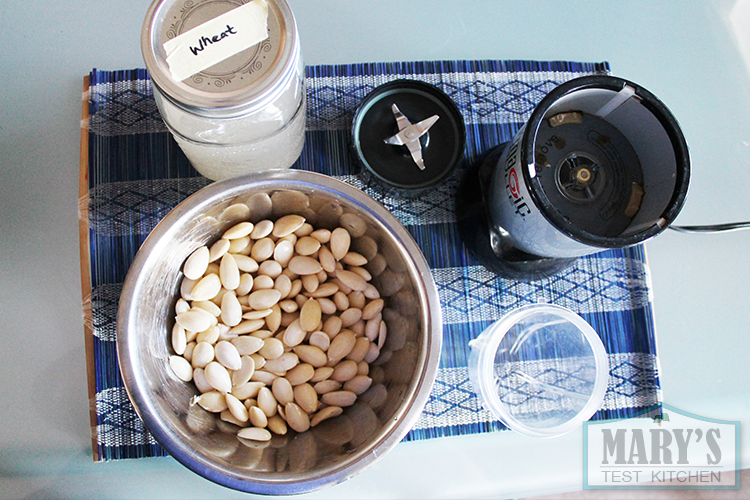
You’re also going to need:
– a large glass jar/container of some kind
– water
– a blender of some kind
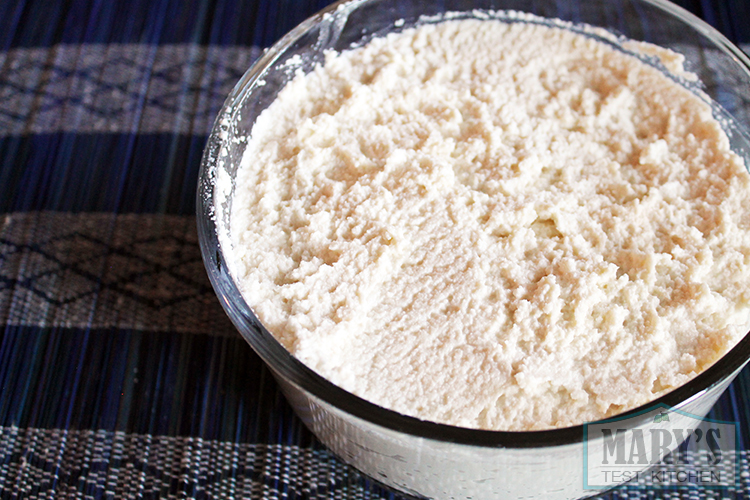
Of course, your cheese will turn out smoother if you use a high-powered blender. But don’t be discouraged if all you have is a bullet/immersion blender/regular ol’ cheapy blender. You’ll just have to add more rejuvelac. You can culture the cheese just the same, then drain the excess water by wrapping the thing in cheesecloth and letting it drain in a colander.
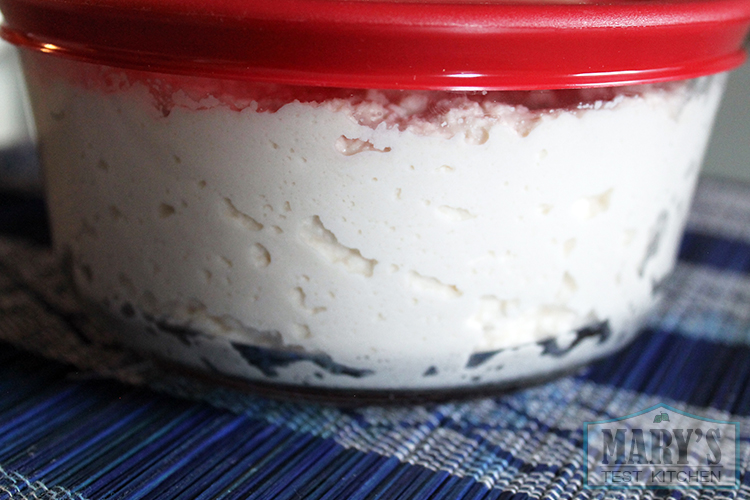
Note that if you have chlorinated tap water like me, you’re going to want to de-chlorinate it before using. You can let a pitcher sit out for a couple hours and the chlorine will dissipate. Or, use boiled water that has cooled to room temperature.
As we’re fermenting stuff at room temperature, it’s super important to work with all clean, sterile equipment. Be aware of cross-contamination (especially when tasting).
Printable recipe for Vegan Cultured Almond Cheese
Cultured Vegan Almond Cheese
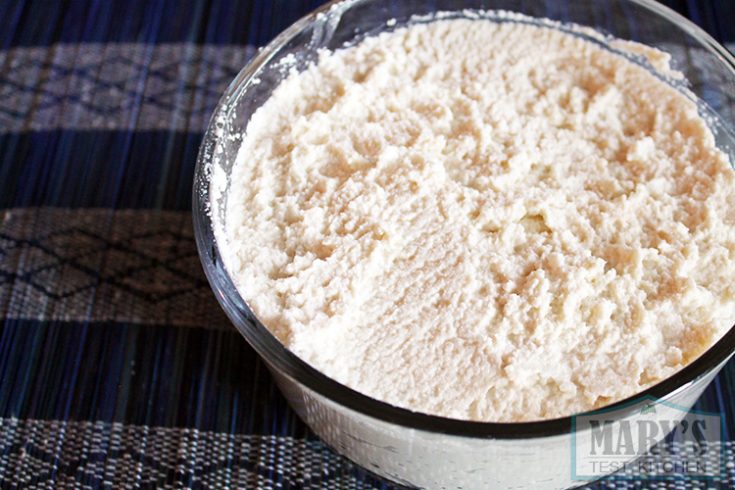
This combination creates a tangy, musky spreadable cheese that is reminiscent of goat cheese. Keep in mind that flavour development depends on factors like temperature and the kind of rejuvelac you use.
Ingredients
- 2 cups raw almonds
- 1/4 cup or more rejuvelac ( I used wheat-based rejuvelac for its musky characteristics)
- a pinch of salt
Instructions
- Soak almonds for 8 to 12 hours at room temperature. Afterwards, de-skin the almonds. Discard the skins and rinse the skinned almonds.
- Combine the almonds and a pinch of salt in your blender. Add about a quarter cup of rejuvelac and start to blend on a medium speed setting.
Increase the blender speed as the almonds break down. Add more rejuvelac as necessary to keep the mixture blending. You may need to pause the blender and tamp the ingredients down. Continue until the mixture is very smooth. - Transfer the almond mixture to a clean glass bowl. Using a clean utensil, take a bit to taste. It should taste bland, just like raw almonds.
- Cover and let ferment at room temperature for a day or two. Taste it to test flavour development. It will develop a mild tanginess and take on a milky, yogurt-y flavour. It will get stronger as it ferments. After that, it's ready to use! Combine it with more salt to taste and feel free to add herbs and spices. Or, use it as a base in other more complex vegan cheese recipes.
Notes
Store this almond culture in the fridge until you're ready to use it. It will continue to ferment slowly so keep tasting to keep track of flavour development.
-
[…] The process is almost exactly like this Cultured Almond Cream Cheese, but it’s even easier as cashews don’t need to be de-skinned and are naturally softer […]
[…] Easy Cultured Almond Cheese […]
Leave a Reply to Mary Cancel reply
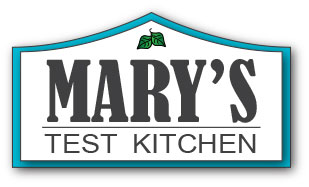
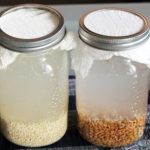
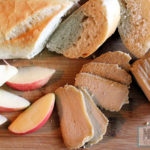
anything we can use in place of homemade rejuvalac to simplify the recipe and cut down on preparation time? have you tried anything premade and ready to use that works just as well?
You can buy rejuvelac in some health food stores. In addition, you can try using a vegan probiotic powder mixed with water. I have not used those myself but have friends who have and say they’ve had great results. <3 Have fun experimenting!
Can I exchange the almonds for cashews? I get the consistency and taste is a bit different so does almonds make it taste a bit more like gruyere compared to cashew nuts?
And just to make sure: I’m also making rejuvelac of quinoa now, is that fine for this type of cheese?
Thanks!
Hi Anna, thanks for asking. Yes you can use cashews, though the taste will be quite different. I find it turns into a mild, yogurt-like cheese that gets tangier the longer you culture it. You can also use other nuts like macadamia or hazelnuts which will also yield an unique taste.
Quinoa rejuvelac is has a brighter, cleaner flavour than wheat-based rejuvelac so it will also produce a different flavour.
The combination of Almond and Wheat-based rejuvelac produces the Gruyere-like flavour.
With cultured cheeses, the flavours vary even due to your environment! Have fun experimenting!
Have you blogged your experiences with the effects of combining different nuts and rejuvelac grains? This would be a nice guide for those of us who are not as productive as you, and so will never become experienced enough to gain your level of expertise.
Thanks!
I’ve really only done wheat and quinoa rejuvelac with almonds and cashews. I’d love to experiment more…but nuts and almonds are pretty expensive here. Perhaps one day when my budget gets a bit bigger. For now, I’m working with my limited grocery budget. Thanks for your request 🙂
i am trying to find the almond cheese not spreadable you talk about making. I cannot find it. I have rejuvalac made and soaked almonds. I want to make a sliceable cheese not a spread. Can I use this recipe and let the water drain for a firmer cheese?
Hi Michelle,
Yes, you can take this recipe and drain it to create a firm cheese. Here is my air-dried almond cheese recipe that uses this recipe as a base: https://www.marystestkitchen.com/almond-gruyere-vegan-cultured-cheese/. Happy experimenting!
Hello, there! Salutations from Brazil 🙂
I used kefir water as a substitute for rejuvelac (since I already drink kefir anyway), left the almonds to ferment for about…23h as I write
And
Oh
My
Dear
Broccoli! Tastes like fermeted death hahahah But the consistensy is divine, I’m in love.
I do might have added too much kefir water, and that led to the sour taste, just so the upper 3/4 of my container are the same as the pictures here, but th lower 1/4 became this very creamy paste (and everything is still separeted from the gross kefir water).
Now let’s go for part 2: the almond gruyere!
Thank you so much for sharing!
Vegan kisses for ya :*
haha that’s so interesting! Fermentation is quite the adventure!
Could I use sauerkraut juice?
Hi Kristine
It might work if it’s unpasteurized sauerkraut juice. Of course, the flavour will be different than if you used rejuvelac.
Good luck!
Mary
Awesome recipe 🙂 thanks for sharing! how long can you keep in the fridge before using it as base for the fermented hard cheese recipe you have?
Hi! Does this recipe call for 2 c almonds before or after soaking? Soaked are about 2ce the size it seems like…thanks!
Hi Kitty,
It’s 2 cups of almonds before soaking. Have fun making almond cheese!
Cheers,
Mary
I really want to try make this one! Sounds great! Maybe with a little MSG it could become mre of a parmegian kinda taste…curious.
I have a question about the rejuvelac fermanting process. Since it’s winter now and fairly cool and humid in my area i was wondering if i could just place everything in my yogurt maker over night at a constant 30 degrees celsius. I haven’t found any indications on the reaction to warmth in rejuvelac but bacteria usually like heat. Any tips or ideas?
Hi Gina,
Good questions but I don’t really know. I haven’t tried adding more heat during the fermentation process. I’ve mostly kept it room temp (about 20 – 25°C) or in the fridge.
-Mary
Thanks for posting all of this. I’m attempting this for the first time and am using 1/4 cup of my homemade kombucha as the fermenting agent. It’s not finished kombucha with flavoring, just the green (mostly) & oolong mix that the scobys have been sleeping in between brews. Will see how it goes and report back.
I was also going to ask about using the yogurt function on my instant pot – it worked with cashews very well, and I was able to make cultured ‘butter’. I also struggle with rejuvelac so I made it will probiotic powder. I will try both ‘experimental alternatives’.
Sorry, I haven’t tried it. Please let me know how it goes if you do!
Cheers,
Mary
It’s worked. I set the yoghurt function to 12 hours. I am moving onto the next step…(making the gruyere style cheese). I also used a 9 Strain probiotic (we don’t really have the strengths per billion on our ingredients here). I am trying again to make rejuvelac with barley, so will try the almond cheeze from there – that looks fantastic. Thanks for testing all of these.
That’s wonderful, Lara! Thanks for sharing!
Cheers,
Mary
Hi! What’s the main purpose of soaking the almonds overnight? Is it to enlarge the almonds or only to skin them? I ask because after an overnight soak it takes me at least 15 seconds to take the skin off one almond. But I’ve seen boiling methods online where the almond easily pops out of the skin. I would want to try the boiling method next time for time, but didn’t know if I was missing out on anything else by the overnight soak.
It’s to hydrate the almonds to make them easier to blend and also makes removing skins easier. If you prefer to boil the almonds, I think it would be okay.
Cheers,
Mary
Do you think I could use almond flour for this recipe with similar results?
Sorry, Kathy. I have no idea! Please let me know if you try it.
Cheers,
Mary
Most municipalities use chloramine in addition to, or instead of chlorine. Unlike chlorine it will not dissipate when left to sit (which is why they use it). You can’t boil it off, and very few water filters will filter it if you’re talking water pitcher.
You can find out if your municipality uses chloramine by going to their water treatment webpage or calling.